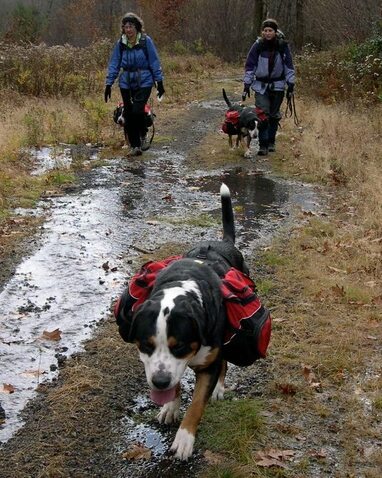EPILEPSY

More than any health issue covered on this web site, I truly want to shine a light on epilepsy. Why? Because too often it is hidden, swept under the carpet, not discussed openly and honestly by anyone other than the pet owners of those dogs affected by this tragic disease. It's no coincidence that this page on epilepsy gets five times more traffic than any other health issue covered on this site. This does not mean that epilepsy is more common than those other problems, but it is generally less discussed, and clearly there is a thirst for knowledge and honest information about epilepsy and its effect on Greater Swiss Mountain Dogs.
Sadly, in this breed there is often a rush to breed very young dogs, and sometimes breed them too often right out of the gate, which may not allow adequate time to get a handle on what that dog is producing. Reproductive technology has enabled us to freeze semen successfully on these stud dogs, so there really should be no rush to use under age dogs or over breed those who are just beginning their breeding careers. Some "breeders" are knowingly breeding the offspring of dogs who have suffered or even died from seizures. Those dogs are at real risk of suffering seizures themselves, and it one can never assume that a dog who hasn't started seizing by the time it's 3 or 4 is somehow safe. It seems it's just as common or Swissies to start seizing between the ages of 4 and 6. I believe that this breed is in real jeopardy and unfortunately it is up to the puppy-buying public to help keep breeders honest.
I have learned what it means to live with an epileptic dog (see Axel's Diary of Epilepsy). Though this was not a total surprise for my Axel, whose pedigree might be called "risky" at best with numerous epileptic relatives, including his father and numerous aunts/uncles, it is still a blow to your heart when you see your dog seize for the first time. I had such hopes for this dog, who finished his championship with ease, had all his health clearances, and was a beautiful, typey, and very sound Greater Swiss Mountain Dog. My plans to special him and one day hopefully pass on the genes that made him so beautiful were set aside. In fact, I had decided not to breed him before he started seizing, before his father started seizing, before his sister started seizing...all based on the incidence of epilepsy on his mother's side of the pedigree. Pretty ironic, huh? My hope then became merely that he would just live...and that he did, until the very day he turned six years of age, when he had the most severe episode of seizing a dog can have...status epilepticus. The resultant onset of hyperthermia (a temp of 106.9) and damage that did to his organs (basically liquefying his brain and causing disseminated intravascular coagulation or DIC) was too much for him to battle this time. He stopped breathing twelve hours after being admitted to the emergency hospital. CPR and attempts to intubate were unsuccessful due to all the blood in his lungs. He expired at 9:30am on February 2nd, 2010 after battling the demon epilepsy for not even 2 years.
Even more than my fears attached to my own dogs, I dread nothing more than receiving a phone call from a terrified puppy buyer who is watching their dog have a seizure for the first time. I don't want to have to take that call. But of course I will. The other thing I will do is accept the diagnosis of epilepsy and not blame the seizures on the puppy buyer for giving the dog that dose of Frontline or that rabies vaccine. Or for not feeding him a raw diet. Or for letting him watch too much television.
While I cannot eliminate epilepsy from this breed, or from my own breeding program for that matter (until we know more about how it is inherited and can test for carriers), I can own up to it when it occurs, share that information with others, and apply some meaningful standards -- like removing affected dogs and any of their offspring from my breeding program. These are not always easy things to do -- what might be considered "throwing away" a perfectly beautiful dog because his father started having seizures? But being a breeder isn't supposed to be easy. We have to make compromises all the time. So do we breed to this dog who's a bit straight and high in the rear, or do we breed to that beautiful dog who has the epileptic parent? I know what my answer would be, but it may be different from others'.
As you can see, I am not afraid to talk about epilepsy. I am afraid of what happens when we don't talk about it. Trust me when I say it has not made me very popular with many GSMD breeders. Some think I must have some political agenda for being outspoken about epilepsy. Others merely think I have no business speaking out about it when they claim that epilepsy was their battle, long before I came onto the scene. Of course, some of those breeders don't even mention the word on their websites. As far as I'm concerned, Axel gave me every right to speak out about this disease. And I am NOT the only Swissy fancier who is deeply concerned and vocal about epilepsy and the tragic impact it has on these dogs and their families. Far from it.
Sadly, in this breed there is often a rush to breed very young dogs, and sometimes breed them too often right out of the gate, which may not allow adequate time to get a handle on what that dog is producing. Reproductive technology has enabled us to freeze semen successfully on these stud dogs, so there really should be no rush to use under age dogs or over breed those who are just beginning their breeding careers. Some "breeders" are knowingly breeding the offspring of dogs who have suffered or even died from seizures. Those dogs are at real risk of suffering seizures themselves, and it one can never assume that a dog who hasn't started seizing by the time it's 3 or 4 is somehow safe. It seems it's just as common or Swissies to start seizing between the ages of 4 and 6. I believe that this breed is in real jeopardy and unfortunately it is up to the puppy-buying public to help keep breeders honest.
I have learned what it means to live with an epileptic dog (see Axel's Diary of Epilepsy). Though this was not a total surprise for my Axel, whose pedigree might be called "risky" at best with numerous epileptic relatives, including his father and numerous aunts/uncles, it is still a blow to your heart when you see your dog seize for the first time. I had such hopes for this dog, who finished his championship with ease, had all his health clearances, and was a beautiful, typey, and very sound Greater Swiss Mountain Dog. My plans to special him and one day hopefully pass on the genes that made him so beautiful were set aside. In fact, I had decided not to breed him before he started seizing, before his father started seizing, before his sister started seizing...all based on the incidence of epilepsy on his mother's side of the pedigree. Pretty ironic, huh? My hope then became merely that he would just live...and that he did, until the very day he turned six years of age, when he had the most severe episode of seizing a dog can have...status epilepticus. The resultant onset of hyperthermia (a temp of 106.9) and damage that did to his organs (basically liquefying his brain and causing disseminated intravascular coagulation or DIC) was too much for him to battle this time. He stopped breathing twelve hours after being admitted to the emergency hospital. CPR and attempts to intubate were unsuccessful due to all the blood in his lungs. He expired at 9:30am on February 2nd, 2010 after battling the demon epilepsy for not even 2 years.
Even more than my fears attached to my own dogs, I dread nothing more than receiving a phone call from a terrified puppy buyer who is watching their dog have a seizure for the first time. I don't want to have to take that call. But of course I will. The other thing I will do is accept the diagnosis of epilepsy and not blame the seizures on the puppy buyer for giving the dog that dose of Frontline or that rabies vaccine. Or for not feeding him a raw diet. Or for letting him watch too much television.
While I cannot eliminate epilepsy from this breed, or from my own breeding program for that matter (until we know more about how it is inherited and can test for carriers), I can own up to it when it occurs, share that information with others, and apply some meaningful standards -- like removing affected dogs and any of their offspring from my breeding program. These are not always easy things to do -- what might be considered "throwing away" a perfectly beautiful dog because his father started having seizures? But being a breeder isn't supposed to be easy. We have to make compromises all the time. So do we breed to this dog who's a bit straight and high in the rear, or do we breed to that beautiful dog who has the epileptic parent? I know what my answer would be, but it may be different from others'.
As you can see, I am not afraid to talk about epilepsy. I am afraid of what happens when we don't talk about it. Trust me when I say it has not made me very popular with many GSMD breeders. Some think I must have some political agenda for being outspoken about epilepsy. Others merely think I have no business speaking out about it when they claim that epilepsy was their battle, long before I came onto the scene. Of course, some of those breeders don't even mention the word on their websites. As far as I'm concerned, Axel gave me every right to speak out about this disease. And I am NOT the only Swissy fancier who is deeply concerned and vocal about epilepsy and the tragic impact it has on these dogs and their families. Far from it.

